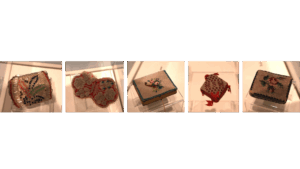
Haudenosaunee (Iroquois)
1 Needle Case, 1800s
2 Needle Case, ca. 1870
Euro American
3 Needle Case, 1800s
4 Pincushion, 1800s
5 Needle Case, 1830
Inscribed: Martha Remember Me. E Palmer 1830
Glass beads on cotton and silk
Gift of the Reverend and Mrs. Van S. Merle-Smith, Jr., 1992; Gift of Pamela Miller Ness and Paul Marc Ness in Memory of Professor and Mrs. Edwin Haviland Miller, 2003. (1992.16.1; 2003.39.176, 260, 273, 274)
These needle cases feature similar materials, despite coming from different cultures. The ones in the back row were made by Haudenosaunee women, for sale to Euro-Americans. Their floral designs reflect Haudenosaunee artistic traditions, but also include raised motifs to appeal to Victorian tastes. By the mid-1800s, beadwork had become an important source of income for Haudenosaunee communities, due to Euro-American disruption of traditional economies.
Euro-American women also made beaded pincushions and accessories, but as a leisure pastime. They often worked from published patterns, like the one on the wall at right.
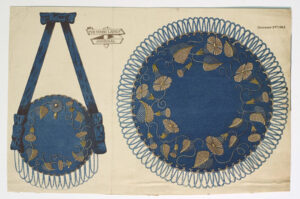
The Young Ladies’ Journal
British or American
Pattern for a Beaded Purse, 1863
Lithograph
Gift of Pamela Miller Ness and Paul Marc Ness in Memory of Professor and Mrs. Edwin Haviland Miller, 2003. (2003.39.550)
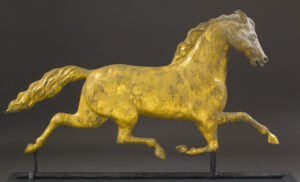
American
Trotting Horse, mid- to late 1800s
Hammered copper, tin wash and gold leaf
Purchase: The Gift of John and Fannie Saeger, 1973. (1973.3)
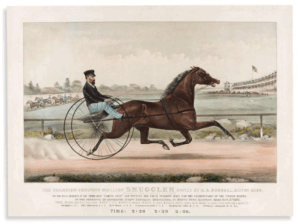
Currier & Ives
The Champion Trotting Stallion Smuggler, 1875,
hand-colored lithograph.
Image courtesy of Swann Auction Galleries.
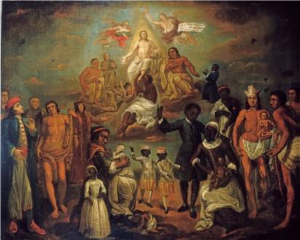
John Valentine Haidt
American, born Germany, 1700–1780
Erstlingsbild (“First Fruits”), ca. 1754–1760
Oil on canvas
Made in Bethlehem, PA
Loan from the Moravian Archives
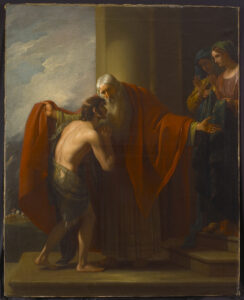
Benjamin West
American, 1738–1820, active in Britain
Return of the Prodigal Son, 1772
Oil on canvas
Made in London
Purchase: Priscilla Payne Hurd Endowment Fund, 2002. (2002.19)
The dramatic light and expressive poses of father and son in this work by Benjamin West contrast with Haidt’s painting at right. West actually took lessons from Haidt as a teen, and his earlier work resembled Haidt’s style. After study in Italy, however, he mastered the realism and subtlety of academic painting, and settled in London where he met great success.
A generation of American artists would travel to London to train with West—including Gilbert Stuart and Rembrandt Peale, whose works are at left.
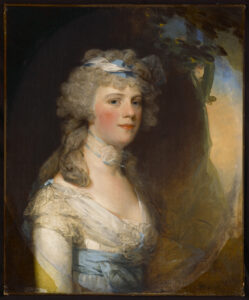
Gilbert Stuart
American, 1755–1828
Ann Penn Allen, ca. 1795
Oil on canvas
Made in Philadelphia, PA
Purchase: The Gift of John and Fannie Saeger, 1978. (1978.13)
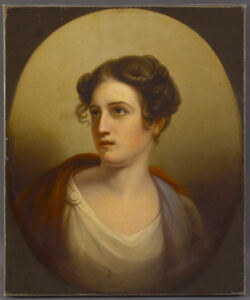
Rembrandt Peale
American, 1778–1860
Erinna, ca. 1830s
Oil on canvas
Made in Philadelphia, PA
Purchase: General Acquisitions Fund; the Gift of Paul Kania; and the Gift of Sam and Missy Saxton, 2002. (2002.22)

American
Sideboard, ca. 1795
Mahogany veneer with satinwood inlay
Made in Philadelphia, PA
Gift of Estate of Robert C. Alexander, 1988.
(1988.14.3)
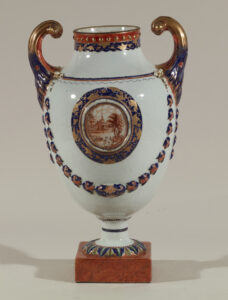
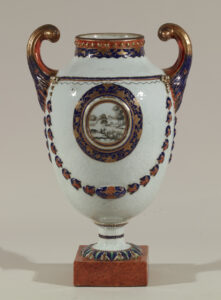
Chinese, for export to Western market
Urns, ca. 1790
Porcelain with enamel overglaze decoration
Gift of Mrs. William P. Hacker, 1981.
(1981.25.1, 2a, b)
The unique shape and delicate decoration of these urns illustrate Chinese artists’ skill in producing porcelain for a Western audience. Using prints and painted wooden models provided by European merchants, Chinese artists created export goods that suited current fashions halfway around the world. On these urns, details like floral swags and faux-woodgrain bases cater to the taste for designs inspired by ancient Greece and Rome.
The United States became a leading importer of Chinese porcelain soon after independence.
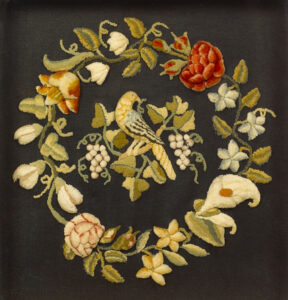
American
Plushwork Wreath, mid-1800s
Canvas with wool plushwork embroidery
Made in Ithaca, NY
Gift of Pamela Miller Ness and Paul Marc Ness in Memory of Professor and Mrs. Edwin Haviland Miller, 2003. (2003.39.313)
The women who made plushwork embroidery often used printed Berlin work embroidery patterns, which were manufactured in Germany and imported into the United States in great numbers by the middle of the nineteenth century. But where Berlin work embroidery laid flat on the surface of the canvas, plushwork extended above the ground, creating a pile. The pile could be trimmed to different heights, as in this example, to make three-dimensional forms.
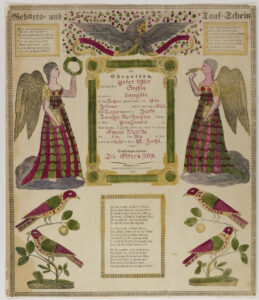
American
Taufschein of Emma Matilda Uhler,
1845
Engraving with watercolor
Inscribed in Forks Township (Northampton County), PA
Printer: Blumer and Busch, Allentown, PA
Gift of Professor and Mrs. Edwin H. Miller, in Memory of Mimi C. Miley, 1995. (1995.30.7)
In spite of its lively decoration, this birth and baptismal certificate was not intended for display. Pennsylvania Germans usually kept such certificates stored away, occasionally taking them out for reflection.
This example, made for Emma Matilda Uhler, maps the relationships key to her moral and spiritual upbringing—her parents, Peter and Sophia Uhler, and the local pastor, Herr Fuchs. The texts in the yellow boxes complete this roadmap for life, reminding Emma of her place with God in heaven.
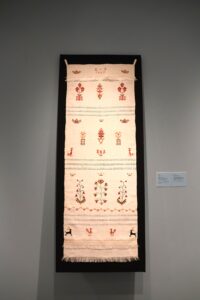
E.S.
American
Show Towel, 1849
Linen plain weave with wool cross stitch
embroidery
Made in southeastern Pennsylvania
Gift of Hampton C. Randolph, Sr., 1989. (1989.47.1)

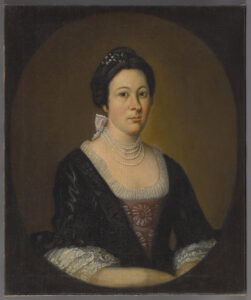
James Claypoole Jr.
American, ca. 1743–1822
Robert Shewell, 1765
Sarah Sallows Shewell, 1765
Oil on canvas
Made in Philadelphia, PA
Purchase: Priscilla Payne Hurd Endowment Fund, and Gift of Francie Starr, 1992. (1992.19.1, 2)
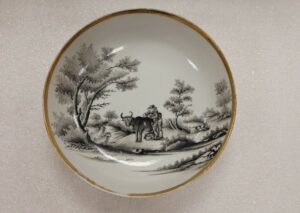
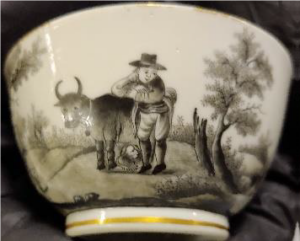
Jingdezhen, China, for export to American market
Cup and Saucer, ca. 1805
Porcelain with black enamel overlay and gilding
Gift of Hampton C. Randolph Sr., 1984. (1984.23.1, 2)
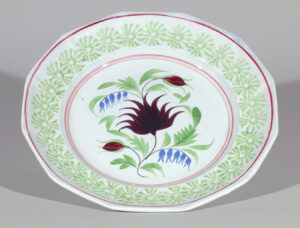
British, for export to Pennsylvania German market
Plate, 1835–1855
Ceramic (spatterware)
Gift of Mr. and Mrs. Arnold Kaplan, 2009. (2009.28.15)
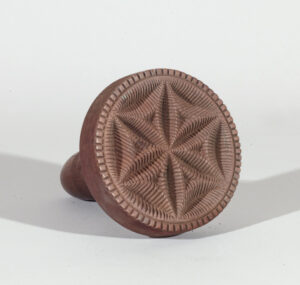
American
Buttermold, 1800s
Poplar
Made in Pennsylvania
Gift of William W. Swallow, 1963.
(1963.152a, b, c)
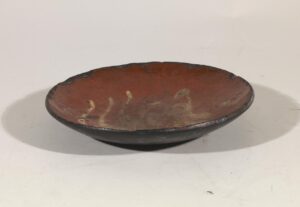
American
Plate, 1800s
Redware
Made in Pennsylvania
Gift of Mr. and Mrs. Herman E. Finkelstein, 1975. (1975.110)
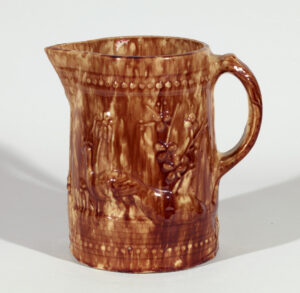
American
Pitcher, 1800s
Ceramic
Gift of Mr. and Mrs. Herman E. Finkelstein, 1975. (1975.122)
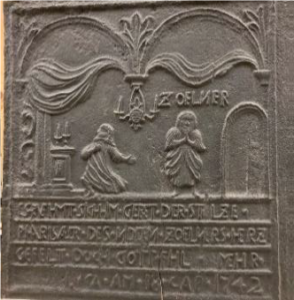
American
Stove Plate: Publican and Pharisee, 1742
Cast iron
Made in Pennsylvania
Inscription: “The proud Pharisee glorifies himself in prayer, but the heart of the humble Publican pleases God much better. Luke Chapter 18, 1742”
Gift of Dorothy C. Miller, 1975. (1975.148)
In the Christian parable of the Pharisee and the Publican, Jesus teaches humility by recognizing the ardent Publican, a Jewish tax collector for the ancient Romans, over the self-righteous Pharisee, a member of an ancient Jewish sect who believed their manner of religious observance superior. The designer of this stove plate based its design on an illustration from a popular German bible (below).
This work not only reflects the transfer of German traditions to Pennsylvania, but also calls to mind iron foundries’ as enslavers. Enslaved people, some of whom may have had experience in West African metalworking techniques, often performed skilled work at mid-Atlantic foundries.
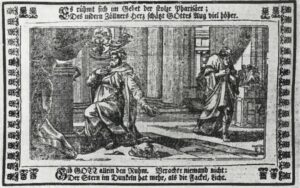
Illustration from the Elector Bible (published in 14 editions, 1640–1758). Pictured in Henry Mercer, The Bible in Iron (Doylestown: Bucks County Historical Society, 1961), 191.
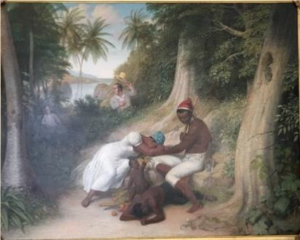
British or French
Cimarrónes or Quilombolas Fleeing Enslavement, ca. 1820s
Oil on canvas
Gift of John (Jay) and Jan Ruhle, 2022. (2022.14)
This painting depicts an enslaved family seeking freedom. Based on the topography and tropical setting, they are likely cimarrónes or quilombolas—people who liberated themselves from enslavement and established free communities in the Spanish Caribbean and Brazil. The sticks of sugarcane on the ground and in the man’s hand suggest that he was forced to labor to produce sugar, a commodity in demand around the world.
Explicit in its detail of the man’s shackles and the distress of the woman and older son, the image was likely meant to inspire sympathy in support of the abolitionist cause to end slavery. The man’s red cap is a symbol of liberty, worn in Roman times by formerly enslaved people who had gained their freedom.
This composition echoes Christian scenes of the Rest on the Flight into Egypt, in which the Holy Family paused during their escape to save the life of the infant Jesus. As the family in the painting here faces the threat of recapture, the young child at the center seems to offer a bit of hope.
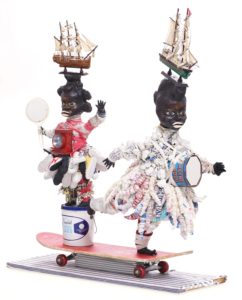
vanessa german
American, born 1976
2 ships passing in the night, or i take my soul with me everywhere i go, thank you, 2014
Mixed media assemblage
Among the inspirations for vanessa german’s sculptures are African nkisi power figures, made from carved wood with ritual accumulations of nails, shells, and other objects. In the words of the artist and poet, 2 ships passing in the night, or i take my soul with me everywhere i go, thank you is:
2 decorative ship models, doll parts, cloth, twine, fear, hair grease, tar, love, skateboard, white beads, homewood beads, rhinestones for the eyes, mirror, antique blue ticking, the ocean, slavery on an everyday basis as made real and present by the reality of white supremacy, righteous clarity, keys, coffee tins, stomach mirror, old jr. navigators flashlight, white porcelain doll heads from the bombed out doll factories in germany, the journey from rage to understanding, the journey from compassion for everyone else to compassion for myself, the journey from lies to truth, the actualization of justice as national migration, old natty quilt parts, pain, and horror and how it feels to know that no one is actually on your side, being blamed for it, pure lard tin, red skateboard
The Petrucci Family Foundation Collection of African-American Art
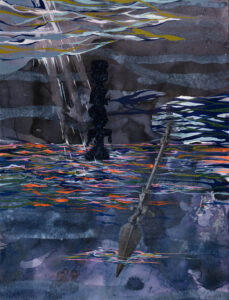
Radcliffe Bailey
American, born Jamaica, 1968
Storm, 2012
Gouache, glitter, and ink with collage
The Petrucci Family Foundation Collection of African-American Art
Radcliffe Bailey’s image of African artifacts floating in a tumultuous ocean suggests the loss of freedom and of life during the Middle Passage, the forced transatlantic journey experienced by enslaved persons brought from West Africa to the Americas.
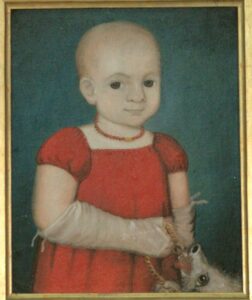
American
Girl in Red Dress, early 1800s
Oil on Masonite, transferred from panel
Gift of Estate of Edgar William and Bernice Chrysler Garbisch, 1981. (1981.19.6)

American
Stag, 1800s
Oil on barrel top
Made in Pennsylvania
Inscription: “You beautiful deer, don’t run so proudly, the hunter stands behind the woods”
Gift of Estate of Edgar William and Bernice Chrysler Garbisch, 1981. (1981.19.8)
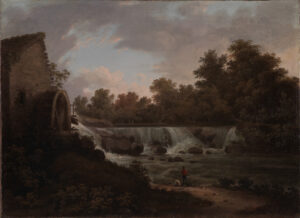
Thomas Birch
American, 1779–1851
Great Falls of the Lehigh at Stoddartsville, Pennsylvania, late 1820s–1830s
Oil on canvas
Purchase: Gift from Three Supporters in Honor of Elliot J. Sussman’s Years of Service to the Allentown Art Museum and the Priscilla Payne Hurd Endowment Fund, 2011. (2011.18)
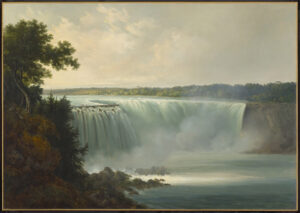
Gustav Johann Grunewald
German, 1805–1878, active in Bethlehem 1831–1868
Niagara Falls, 1834
Oil on canvas
Purchase: The Gift of John and Fannie Saeger, 1986. (1986.7)
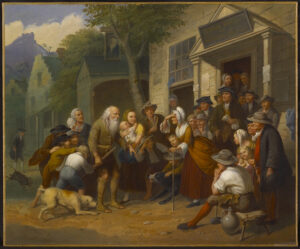
Tompkins Harrison Matteson
American, 1813–1884
The Return of Rip Van Winkle, or, Rip Van Winkle’s Return from the Mountains,
1840–1845
Oil on canvas
Purchase: The Leigh Schadt and Edwin Schadt Art Museum Trust, 2001. (2001.10)
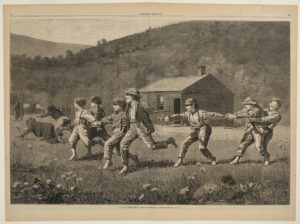
After Winslow Homer
American, 1836–1910
Snap the Whip from Harper’s Weekly, September 20, 1873
Wood engraving
Engraver: W.H. Lagarde
Publisher: Harper & Brothers, New York, NY
Gift of Paul K. Kania, 2018. (2018.23.2)
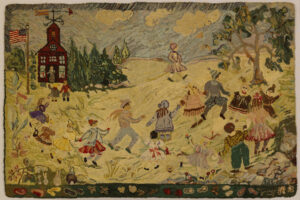
American
Hooked Rug, 1890–1900
Wool and cotton fabric strips hooked to burlap ground
Gift of Pamela Miller Ness and Paul Marc Ness in Memory
of Professor and Mrs. Edwin Haviland Miller, 2003.
(2003.39.369)
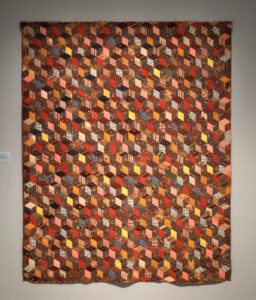
American
Tumbling Blocks Quilt, ca. 1840s
Pieced and quilted cotton
Collection of Arlan and Pat Christ.
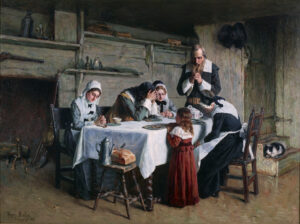
Henry Mosler
American, 1841–1920
Invoking God’s Blessing (Pilgrim’s Grace), 1897
Oil on canvas
Gift of Mr. and Mrs. Norman Hirschl, 1977. (1977.4)
In their humble home, this Pilgrim family embodies faith, morality, and simplicity—values that some Americans feared were disappearing in the late 1800s. Artists like Henry Mosler depicted the past to offer inspiration and reassurance to those worried about urbanization and immigration transforming the United States.
Such artists were usually more concerned with celebrating American identity than with historical accuracy. Look for fun anachronisms in this painting, such as the very Victorian bows, and painted Chinese porcelain (rare in North America until about a century after the Pilgrims’ time).
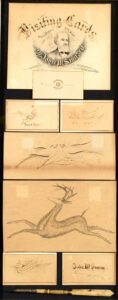
John M. Swasey
Calligraphic Drawings and Cards with Pen, 1880s
Ink on paper
Gift of Pamela Miller Ness and Paul Marc Ness in Memory
of Professor and Mrs. Edwin Haviland Miller, 2003.
(2003.39.4.1–8)
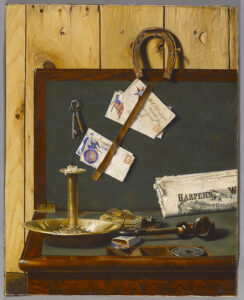
George Cope
American, 1855–1929
Mr. Darlington’s Still Life, 1890
Oil on canvas
Made in West Chester, PA
Purchase: Leigh Schadt and Edwin Schadt Art Museum Trust Fund, 2004. (2004.35)
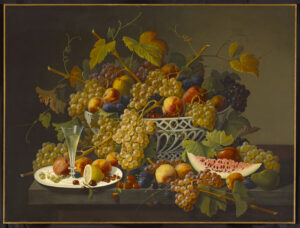
Severin Roesen
German, ca. 1815–ca. 1872, active in the United States
Still Life with Wine Glass and Watermelon, ca. 1860
Oil on canvas
Purchase: Frank E. and Seba B. Payne Foundation Gift, 1987. (1987.41)
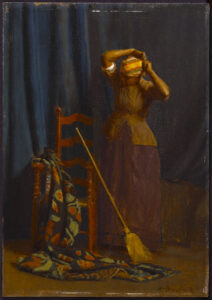
Thomas Pollock Anshutz
American, 1851–1912
The Chore, ca. 1888
Oil on wood panel
Made in Philadelphia, PA
Purchase: J. I. and Anna Rodale Fund, 1949.(1961.26)
What might the woman who posed for this painting have thought about the finished work? Artist Thomas Anshutz—who was white—hired her to model because he wanted to paint a Black female servant, and chose the studio props, her pose, and the scarf she wears.
Either she or someone close to her probably had experience working as a servant: an 1899 study by W.E.B. DuBois and Isabel Eaton found that 90% of Black women employed in Philadelphia at this time were in domestic service. Maybe this woman preferred modeling to her regular job—or perhaps it was more tiring to work with Anshutz.
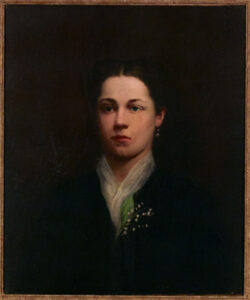
Susan Macdowell Eakins
American, 1852–1938
Kate Lewis, 1884
Oil on canvas
Made in Philadelphia, PA
Purchase: J. I. and Anna Rodale Fund, 1945. (1961.21)
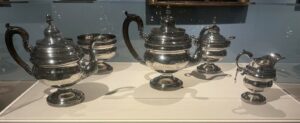
William Seal
American, active 1810–1822
Coffee Pot, Creamer, Teapot, Sugar Bowl, Waste Bowl, Tongs, ca. 1817
Silver
Made in Philadelphia, PA
Anonymous Loan
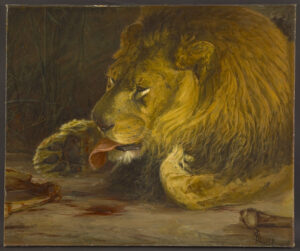
Henry Ossawa Tanner
American, 1859–1937, active in France
Lion Licking Paw, 1886
Oil on canvas
Made in Philadelphia, PA
Gift of Mr. and Mrs. Philip I. Berman, 1962. (1962.5)
Henry Ossawa Tanner painted this lion from life at the Philadelphia Zoo. He was preparing to make a larger work depicting Androcles, a formerly enslaved Roman who stopped to remove a thorn from a lion’s paw while fleeing his enslavers.
Tanner often explored stories of oppression and freedom in his work. As the son of a woman who liberated herself from slavery, and as an expatriate who left the United States to mitigate racism’s impact on his career, he likely found particular significance in these themes.
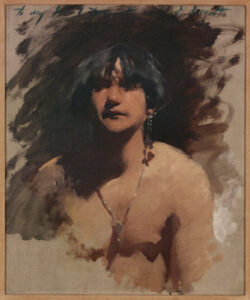
John Singer Sargent
American, 1856–1925, active in Europe
Head of a Young Woman,
1878–1880
Oil on canvas
Gift of Katherine Merle‑Smith Thomas, 2008.
(2008.22)

